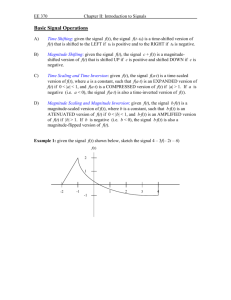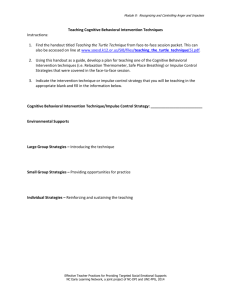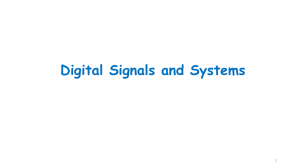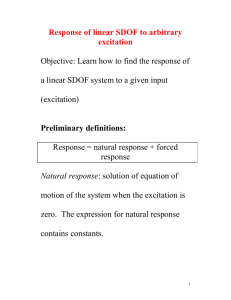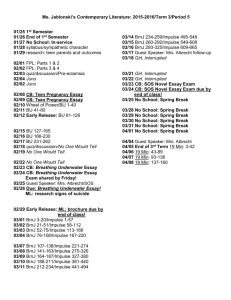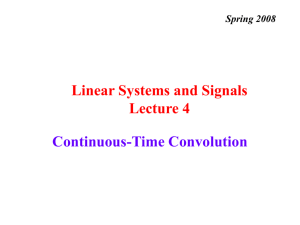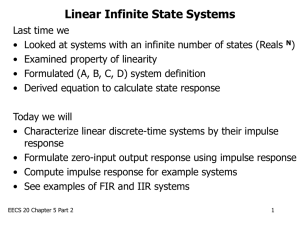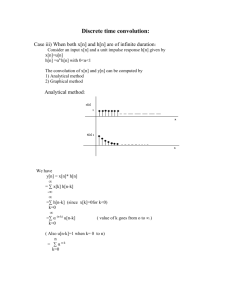Discrete Signal Processing Lecture 2 The Unit Impulse (Unit Sample)
advertisement
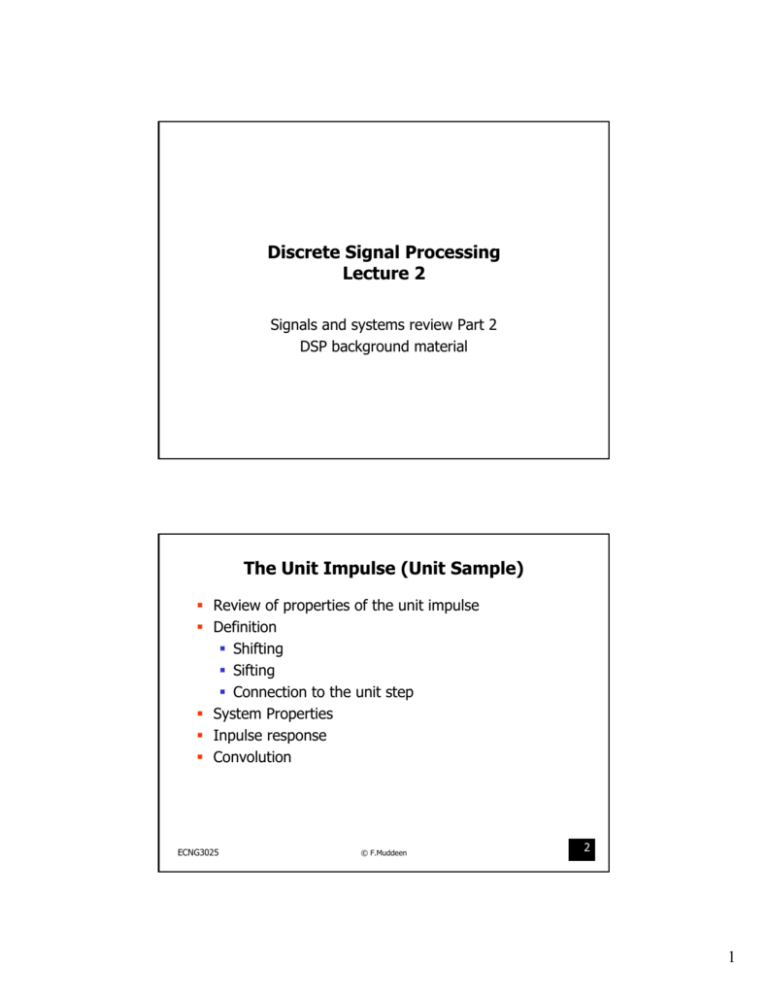
Discrete Signal Processing
Lecture 2
Signals and systems review Part 2
DSP background material
The Unit Impulse (Unit Sample)
Review of properties of the unit impulse
Definition
Shifting
Sifting
Connection to the unit step
System Properties
Inpulse response
Convolution
ECNG3025
© F.Muddeen
2
1
Unit impulse (unit sample)
Defined as:
δ [n] = 0, n ≠ 0
= 1, n = 0
Shifted (Delayed)
2
2
1.8
1.8
δ [n]
1.6
1.4
1.6
δ [n − 3]
1.4
1.2
1.2
1
1
0.8
0.8
0.6
0.6
0.4
0.4
0.2
0.2
0
-8
-6
-4
-2
0
2
4
6
ECNG3025
0
-4
8
-2
0
2
4
6
8
10
12
3
© F.Muddeen
Unit impulse and Unit step
Close relationship
Unit impulse is first difference of unit step
δ [n] = u[n] − u[n − 1]
Remember that CT impulse was the first derivative of the
CT step
Alternatively:
u[n] =
∞
∑ δ [ m]
m = −∞
Called a running sum.
Analogous to integration
Only non zero value is at m = 0, so that summation
agrees with definition of the unit step.
ECNG3025
© F.Muddeen
4
2
Sifting Property
Multiplying any sequence
signal
by a unit impulse selects or
‘sifts’ out the value of the sample
signal at the instant of the
impulse:
x[n] ⋅ δ [n] = x[0]
x[n] ⋅ δ [n − k ] = x[k ]
The well known sifting property of impulses
We can ‘build’ any sequence using this property
Called Sampling
ECNG3025
5
© F.Muddeen
DT sequence from Impulses
Does this
look
familiar?
A convolution
type summation
ECNG3025
© F.Muddeen
6
3
Summarising
ECNG3025
© F.Muddeen
11
Summarising
ECNG3025
© F.Muddeen
12
6
Systems
A discrete-time system transforms an input sequence
into an output sequence according to some
input/output rule.
Can be done sample by sample
Thus:
H
[ x0 , x1 , x2 , L xn ] ⎯⎯→
[ y0 , y1 , y2 ,L yn ]
Called sample by sample processing
Real-time systems would use this technique
ECNG3025
13
© F.Muddeen
Systems
OR
⎡ x0 ⎤
⎡ y0 ⎤
⎢y ⎥ = y
H
x = ⎢⎢ x1 ⎥⎥ ⎯⎯→
⎢ 1⎥
⎢⎣ xn ⎥⎦
⎢⎣ yn ⎥⎦
Called block processing
For
systems
where data
is stored
⎡2 0 0⎤ ⎡ x0 ⎤
y = Hx = ⎢⎢0 3 0⎥⎥ ⎢⎢ x1 ⎥⎥
⎢⎣0 0 4⎥⎦ ⎢⎣ x3 ⎥⎦
The technique used depends on the particular DSP
application
ECNG3025
© F.Muddeen
14
7
Required System Properties
Linearity
If input consists of a number of weighted signals
Overall response is a linear superposition of
responses to each individual signal.
Thus:
F [a1 x1 (n) + L + an xn (n)] = a1F [ x1 (n)] + L + an F [ xn (n)]
ECNG3025
© F.Muddeen
15
Properties of DSP systems
Time-invariance
Relationship between input and output does not
change with time
If
y[n ] = F [ x[n ]] then
y[n − k ] = F [ x[n − k ]] and
y[ n ] = y[ n − k ]
Causality
System is causal if the output of system only
exists for n ≥ 0
Most commonly encountered type of systems
ECNG3025
© F.Muddeen
16
8
Causal Signal
Discrete-time signal
Made up of a set of weighted unit samples
(impulses) with appropriate delay.
Thus
Will discuss this in
detail when dealing
∞
with sampling
x ( n) =
x(k )δ (n − k )
∑
k =0
No signal before
n=0 (causal)
ECNG3025
17
© F.Muddeen
Impulse Response
Linear time invariant (LTI) systems are uniquely
characterised by their impulse response
Recall this from earlier
on
So that each
ECNG3025
x[n] =
∞
∑ x[k ]δ [n − k ]
k = −∞
δ [n − k ] → h[n − k ]
© F.Muddeen
18
9
Impulse Response
Therefore y[ n] =
∞
∑ x(k )h[(n − k ]
k = −∞
•This is also expressed as:
n = 0, 1, 2, K
y[n] = x[n] ∗ h[n]
The convolution sum
ECNG3025
© F.Muddeen
19
Impulse Response
If h[n] does not converge
Infinite Impulse Response system
IIR
If h[n] converges
Finite Impulse Response system
FIR
To be discussed
ECNG3025
© F.Muddeen
20
10
The Convolution Equation
Let us assume a causal sequence
∞
y[n] = ∑ x(k )h[(n − k ] n = 0, 1, 2, K
k =0
∞
y[0] = ∑ x(k )h[(0 − k )]
k =0
What is h[-k]?
ECNG3025
That is simply ©h[k]
reversed (‘flipped’)
F.Muddeen
21
Continuing
y[0] = x(0)h(0) + x(1)h( −1) + x(2)h(−2) + K +
∞
y[1] = ∑ x(k )h[(1 − k )]
k =0
h[-k] shifted right
once! That is a slide
y[1] = x(0)h(1 − 0) + x(1)h(1 − 1) + x(2)h(1 − 2) + K +
y[1] = x(0)h(1) + x(1)h(0) + x(2)h(−1) + K +
ECNG3025
© F.Muddeen
22
11
Eventually
y[2] = x(0)h(2) + x(1)h(1) + x(2) h(0) + K +
Let us apply this to an example and observe
the pattern
x[n]=[1 3 4]
h[n]=[5 4 2]
Find y[n]=x[n]*h[n]
ECNG3025
23
© F.Muddeen
Start
n
x[k]
h(-(k))
-2
-1
2
4
0
1
5
1
3
Reversed
sequence
2
4
3
4
5
6
7
Overlap
begins here
y[0] = x(0)h(0) + x(1)h( −1) + x(2)h(−2) + K +
y[0] = (1)(5) = 5
ECNG3025
© F.Muddeen
24
12
Shift once (‘slide’)
n
x[k]
h(-(k))
h(1-k)
-2
-1
0
1
1
3
2
4
5
2
4
3
4
5
6
7
Overlap zone
y[1] = x(0)h(1) + x(1)h(0) + x(2)h(−1) + K +
y[1] = (1)(4) + (3)(5) = 19
ECNG3025
25
© F.Muddeen
Slide again
n
x[k]
h(-(k))
h(1-k)
h(2-k)
-2
-1
0
1
1
3
2
4
2
4
5
3
4
5
6
7
Overlap zone
y[2] = x(0)h(2) + x(1)h(1) + x(2) h(0) + K +
y[2] = (1)(2) + (3)(4) + (4)(5) = 34
ECNG3025
© F.Muddeen
26
13
Finish off
n
x[k]
h(-(k))
h(1-k)
h(2-k)
h(3-k)
h(4-k)
h(5-k)
-2
-1
2
4
2
0
1
5
4
2
1
3
5
4
2
2
4
5
4
2
3
5
4
2
4
5
4
5
7
y(n)
y(0)=5
y(1)=19
y(2)=34
y(3)=22
y(4)=8
y(5)=0
5
x[n]=[1 3 4]
h[n]=[5 4 2]
Find
y[n]=x[n]*h[n]
Answer
[5 19 34 ©22
8]
F.Muddeen
ECNG3025
6
Overlap ends
here
27
Another approach
∞
y[n] = ∑ x(k )h[(n − k )]
k =0
y[0] = x(0)h(0) + x(1)h( −1) + x(2)h(−2) + K +
y[1] = x(0)h(1) + x(1)h(0) + x(2)h(−1) + K +
y[2] = x(0)h(2) + x(1)h(1) + x(2) h(0) + K +
.
.
.
ECNG3025
If we are dealing with causal systems
then h(-1), h(-2) etc are zero
© F.Muddeen
28
14
Another approach
∞
y[n] = ∑ x(k )h[(n − k )]
k =0
y[0] = x(0)h(0)
y[1] = x(0)h(1) + x(1) h(0)
y[2] = x(0)h(2) + x(1)h(1) + x(2) h(0)
.
.
.
Let’s enter this into a table
ECNG3025
29
© F.Muddeen
Using 4 terms for x[n] and 3 for h[n]
x[0]
h[0]
h[0]x[0]
h[1]
h[1]x[0]
x[1]
x[2]
x[3]
x[4]
h[0]x[4]
h[2]
h[3]
h[3]x[0]
h[3]x[4]
Called a Convolution Table
ECNG3025
© F.Muddeen
30
15
Enter the values from our example
Sum across the anti-diagonals
1
3
4
5
5
15
20
4
4
12
16
2
2
6
8
y[0] = x(0)h(0) = 5
y[1] = x(0)h(1) + x(1)h(0) = 19
y[2] = x(0)h( 2) + x(1)h(1) + x(2)h(0) = 34 y[3] = 22
y[4] = 6
ECNG3025
31
© F.Muddeen
Sequence Xn
Sequence Hn
4
5
4
3
3
2
2
1
0
1
1
1.5
2
2.5
3
0
1
1.5
2
2.5
3
Sequence Yn
35
30
Graphical
representation of
results
25
20
15
10
5
0
ECNG3025
1
2
3
4
5
© F.Muddeen
32
16
Example
Find the output of a finite
response system h[nT ] = nT to
the input signal x[nT ] = e − nT ,
where T = 0.1s and n = 0 to 3
Step 1
Find the sequences
h[nT]=?
x[nT]=?
ECNG3025
© F.Muddeen
33
Using MATLAB conv function
%
%
%
Use of the conv function
ECNG3025 2006
(c) F.Muddeen
n=0:3;
Xn=exp(-0.1*n);
Hn=0.1*n;
Yn=conv(Xn,Hn);
Subplot(2,2,1),stem(Xn,'fill');Title('Sequence Xn');
Subplot(2,2,2),stem(Hn,'fill');Title('Sequence Hn');
Subplot(2,2,3),stem(Yn,'fill');Title('Sequence Yn');
ECNG3025
© F.Muddeen
36
17
Using MATLAB conv function
Sequence Xn
Sequence Hn
1
0.4
0.8
0.3
0.6
0.2
0.4
0.1
0.2
0
1
2
3
4
0
1
2
3
4
Sequence Yn
0.8
0.6
The results agree with
those obtained before
0.4
0.2
0
0
ECNG3025
2
4
6
8
© F.Muddeen
37
18

